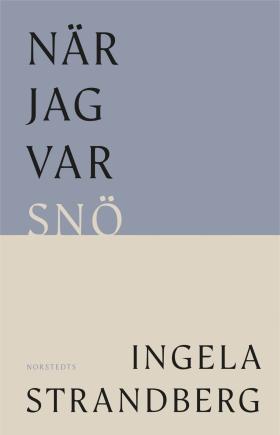
När jag var snö
(When I was Snow)
by Ingela Strandberg
reviewed by Darcy Hurford
Ingela Strandberg’s writing career stretches back several decades, encompassing children’s books and novels, but focusing mainly on poetry. In her latest work, När jag var snö (‘When I Was Snow’), the central event is the death of a beloved cat and the passing of time thereafter. Without any sentimentality, its death is followed by imagery and thoughts relating to grief and life. It’s arranged as one continuous text, but certain passages draw you back in again.
In the opening lines, the cat has already been put in the car and is being taken to be buried. This leads immediately to a series of images that clearly state we are far away from any idealisation of pretty landscapes:
With the dead cat in the back seat
we drive through the landscape’s
lying light
The cherry-trees stand in
wedding clothes
The maples entice us shamelessly with
sugar
The cat contemplates
with wide-open eyes the clover of the death
meadows
Nature’s lifted her skirt
She’s no more than a whore
It’s not often that this reviewer thinks of Kurt Cobain while reading a poem, and in fact it may never have happened before, but the Nirvana song ‘In Bloom’ came to mind at that last line. This is nature as something promiscuous, that just keeps on going, starkly oblivious to the loss of life that’s just occurred and focused purely on reproduction. Sluttiest of trees, the cherry now, to misquote Housman. These are striking images that stick in the mind, and there are many more elsewhere in this work.
The cat is buried, its green eyes, ‘small paperweights of glass’, staring into the unfathomable. From this point on, the poet returns in her thoughts to the cat now and again, and it seems to take on the role of an intermediary between this world and the next, no longer being alive in this world physically yet still present as an idea. A cat is just a cat, you might argue, and not worth a poem. But this isn’t about this individual cat per se, we learn nothing whatsoever about this particular cat – it remains nameless, featureless. Instead, it’s the loss – a small one, but still – and the rage against natural loss articulated in the poems that is the main impetus in När jag var snö. And it has implications for humans as a reminder of their own mortality:
Sorrow is a quiver
Loss weariness
Under my thin skin
tick thousands of small small
clocks
Time passes. The cat has lain in the ground for a hundred days, yet ‘in the great mirror outside the village a hundred days are / nothing’. To the world at large, the cat makes no difference. Time matters to the cat though, and the poem follows the process of physical decay to a striking extent:
The dead cat seethes
and is emptied seethes and is emptied
There’s something disconcerting yet effective in the way Strandberg juxtaposes the unappealing (rotting cat) with the rhythm of the repetition, and later there’s a similarly contrastive combining of decay and mythology as the poet lies ‘listening to death in the cat’, and, while decay slowly moves on, ‘Jupiter dances in the East’.
If the border between life and death is porous, so is the dividing line between humans and animals and things. Strandberg describes someone laying asphalt on the county road as ‘an animal in human form / a chance assembly / of materia’ and later describes her own body as a pitcher, ‘filled and foaming to the brim’. She remembers seeing an old woman milking a cow, and says her body resembled ‘the prow on a hull’. Again there is a reference to mythology – the Pleiades are approaching evening – and they were seven sisters transformed into stars by Zeus, so there is a line of female figures – the woman, the cow, the stars, maybe even the ship.
The poem ends with the cat apparently returning as a tramp with no home, following its own tracks. När jag var snö makes no attempt to gloss over the fact that nature is, as Tennyson put it, ‘red in tooth and claw’. On the contrary, nature is brutal and death and life go hand in hand. But nature in this poem has an agency of its own. Flowers aren’t simply pretty, maple syrup is not simply sweet, and a cat is not simply a cat.

När jag var snö
Norstedts, 2024
46 pages
Foreign Rights: Lina Sjögren, Norstedts
När jag var snö won the Swedish Radio Poetry Prize in 2023. Ingela Strandberg has been awarded a string of other prizes, most recently the Swedish Academy’s Nordic Prize.
